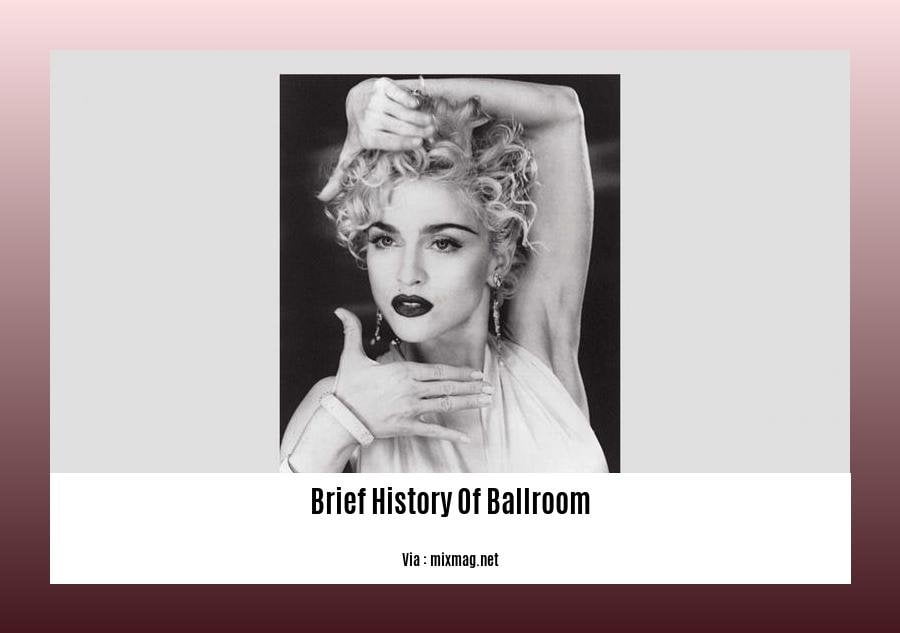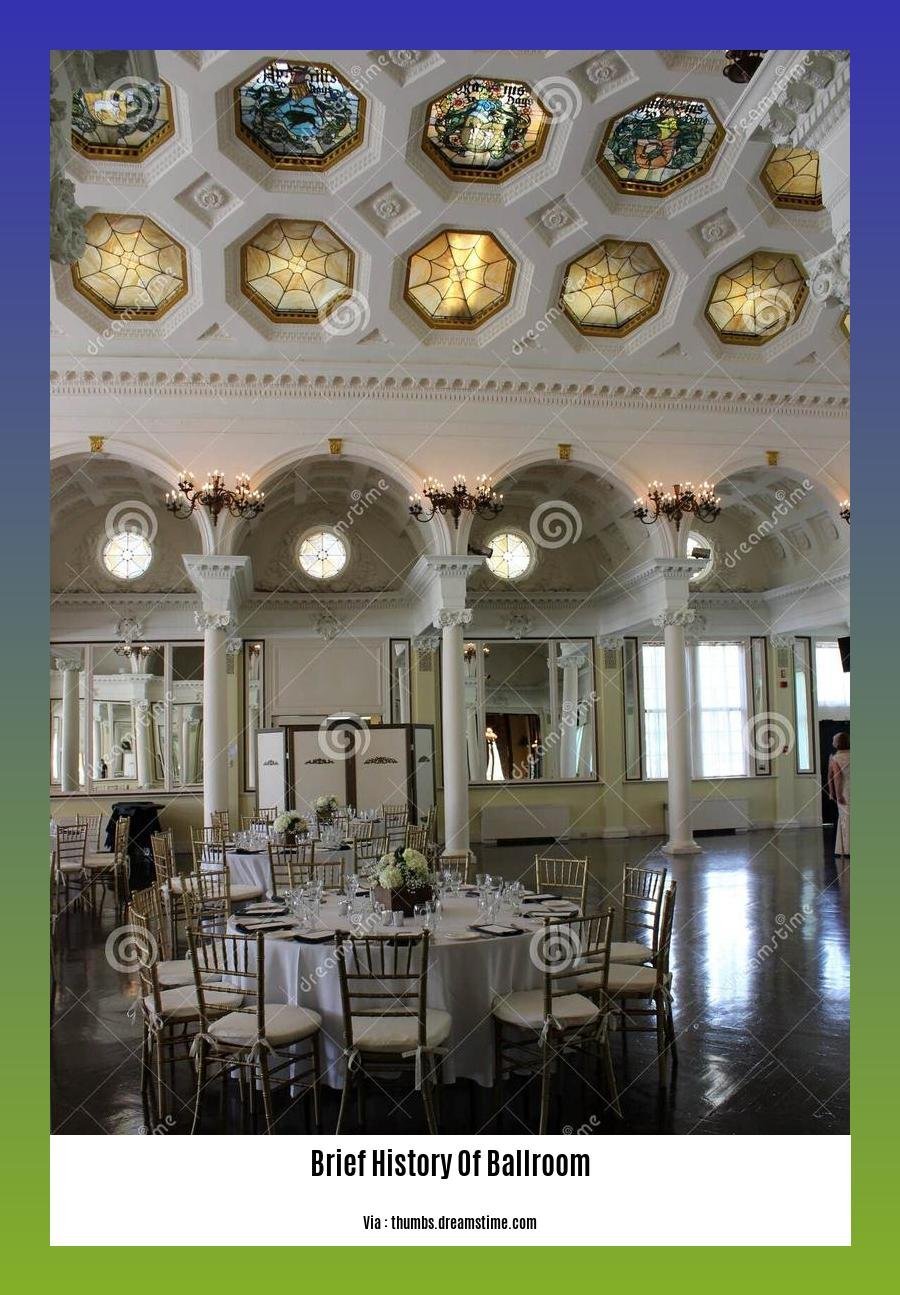Embark on a captivating journey through the annals of ballroom dance in [A Brief History of Ballroom: A Journey Through Elegance and Graceful Movement], a treatise that unveils the rich heritage and evolution of this mesmerizing art form. Witness the transformation of ballroom from its humble origins to its current status as a global phenomenon, captivating audiences with its elegance, athleticism, and timeless allure.
Key Takeaways:
- Ballroom dancing originated in Europe and the US, initially used for social events.
- The first documented guide was Jehan Thoinot Arbeau’s book Orchesographie (1588).
- Standard dances include the waltz, polka, foxtrot, two-step, and tango.
- Others like the Charleston, swing, mambo, twist, and disco are also included.
Brief History of Ballroom: Elegance and Graceful Movement

A brief history of ballroom is a voyage through cultures, eras, and the evolution of human expression. It’s about how dance became a mirror of society, reflecting the elegance, grace, and social norms of each age.
Ballroom’s European Roots
- Ballroom dance traces its roots back to Europe, where it emerged as a form of social entertainment among the aristocracy.
- The first documented account of ballroom dance dates back to the 16th century, with the publication of Orchesographie by Jehan Thoinot Arbeau, outlining the dances and etiquette of the French court.
The Waltz Takes the Stage
- The waltz, introduced in the late 18th century, revolutionized ballroom dancing.
- Its graceful, flowing movements challenged the rigid, formal dances of the past, symbolizing a shift towards greater freedom and expression.
A Journey Across the Atlantic
- Ballroom dance crossed the Atlantic to the United States in the 19th century, finding a home in the grand ballrooms of New York, Boston, and other major cities.
- The popularity of the waltz led to the development of new dances like the polka, schottische, and mazurka.
The Roaring Twenties and Beyond
- The early 20th century saw the rise of new dance crazes, such as the Charleston and the foxtrot, which reflected the exuberance and energy of the Roaring Twenties.
- Later decades introduced the jitterbug, swing, and disco, each adding unique flavors to the ever-evolving world of ballroom dance.
Ballroom Today: A Global Phenomenon
- Today, ballroom dancing is a global phenomenon, practiced and enjoyed by people of all ages and cultures.
- From the grand ballrooms of Europe to the dance studios of modern cities, ballroom dance continues to captivate hearts, fostering a sense of community and providing an outlet for creativity and self-expression.
A Legacy of Elegance and Grace
- The brief history of ballroom is a testament to the enduring power of dance as an art form.
- Through centuries of change, ballroom dance has maintained its essence: a celebration of elegance, grace, and the joy of human movement.
Discover the evolution of Apple’s iconic brand identity and the role of Alan Turing in its creation by exploring the history of the Apple logo.
Delve into the history of Apple stores, from their humble beginnings to their current status as global retail powerhouses, through a comprehensive timeline of events.
Embark on a journey through Apple’s history, tracing its revolutionary innovations and pivotal moments in a comprehensive timeline that spans decades of tech industry dominance.
Changing Social Norms: Investigate how societal shifts, such as the Industrial Revolution and changing gender roles, influenced the evolution of ballroom dancing and its increasing popularity among the masses.
The evolution of ballroom dancing is intricately linked to societal shifts that have reshaped how we live and interact. The Industrial Revolution catalyzed a surge of urbanization, which brought diverse people from different backgrounds together. This convergence created a fertile ground for the exchange of ideas, including dance forms, leading to the emergence of new styles and techniques.
Moreover, the Industrial Revolution ushered in an era of increased leisure time for the working class. This newfound freedom allowed people to pursue recreational activities, and ballroom dancing became a popular way to socialize, relax, and showcase one’s skills. Dance halls and ballrooms sprang up across cities, providing venues for people to gather, connect, and lose themselves in the rhythm of the music.
The Industrial Revolution also brought about profound changes in gender roles. Women gained more independence and freedom of movement, challenging traditional social norms. This shift was reflected in the evolution of ballroom dance, as women began to take on more active roles, breaking free from the constraints of the past.
In the early days of ballroom dancing, women were expected to follow the lead of their male partners, adhering to strict rules and conventions. However, as societal norms evolved, women began to assert their individuality and express themselves more freely through dance. They adopted more daring and intricate movements, challenging the traditional gender dynamics of the dance floor.
The changing gender roles also had a significant impact on the popularity of ballroom dancing among the masses. As women gained more social and economic independence, they became more visible and influential in society. This led to an increased demand for dance instruction and opportunities to participate in ballroom dancing, making it a more inclusive and accessible activity for people from all walks of life.
Key Takeaways:
The Industrial Revolution fueled urbanization, fostering a melting pot of diverse cultures and dance forms.
Increased leisure time for the working class made ballroom dancing a popular recreational activity.
Changing gender roles empowered women to break free from traditional dance conventions and express themselves more freely.
Ballroom dance became more inclusive and accessible as women gained social and economic independence.
The evolution of ballroom dance reflects the dynamic interplay between societal shifts and cultural expression.
Citations:
[1] Royal Society Publishing:
[2] National Library of Medicine:
Emergence of Competitive Ballroom: Highlight the emergence of competitive ballroom dancing in the late 19th century, tracing its growth and the establishment of standardized rules and regulations.

In the late 19th century, a fascinating dance phenomenon emerged: competitive ballroom dancing. This captivating spectacle transformed ballroom from a leisurely pastime to a highly skilled and competitive art form. Let’s delve into this intriguing journey, tracing its evolution and the establishment of standardized rules that shaped the world of competitive ballroom.
Key Moments in the Emergence of Competitive Ballroom:
Birth of Dance Competitions: The first documented competitive ballroom event took place in London in 1892, marking the official inception of competitive ballroom dancing. This groundbreaking event set the stage for the rise of professional ballroom competitions worldwide.
Standardization of Dance Steps: To ensure fairness and consistency in competitions, standardized dance steps and patterns were introduced. This standardization process laid the foundation for the technical precision and uniformity that characterize modern ballroom dancing.
Formation of Governing Bodies: The need for regulation led to the establishment of governing bodies such as the Imperial Society of Teachers of Dancing (ISTD) in 1904 and the National Dance Congress of America (NDCA) in 1920. These organizations played a crucial role in codifying rules, setting standards, and promoting the sport.
Growth and Expansion of Competitive Ballroom:
Rise of Professional Dancers: With the advent of competitions, a new breed of professional dancers emerged. These highly skilled individuals dedicated their lives to mastering the art of ballroom dancing, captivating audiences with their grace, athleticism, and artistry.
International Competitions: The popularity of competitive ballroom dancing soared, leading to the establishment of international competitions. These events showcased the talents of dancers from around the world, fostering cultural exchange and camaraderie among the global ballroom community.
Television and Media Exposure: The advent of television in the mid-20th century brought competitive ballroom dancing into the living rooms of millions. This exposure catapulted the sport into the mainstream, attracting a wider audience and inspiring a new generation of dancers.
Enduring Legacy of Competitive Ballroom:
Today, competitive ballroom dancing thrives as a global phenomenon, captivating audiences with its elegance, athleticism, and artistry. It has become an integral part of the performing arts world, with prestigious competitions held worldwide and professional dancers gracing the stages of renowned theaters and dance venues.
Key Takeaways:
The emergence of competitive ballroom dancing in the late 19th century transformed it from a social activity to a highly skilled and competitive art form.
Standardization of dance steps, patterns, and the formation of governing bodies ensured fairness and consistency in competitions.
Professional dancers emerged, showcasing their talents in international competitions and captivating audiences worldwide.
Television and media exposure brought competitive ballroom dancing into the mainstream, inspiring a new generation of dancers.
Today, competitive ballroom dancing thrives as a global phenomenon, captivating audiences with its grace, athleticism, and artistry.
Source:
[1] Britannica, The Editors of Encyclopedia. “Ballroom Dance.” Encyclopedia Britannica, Encyclopedia Britannica, Inc., 29 Apr. 2021,
Ballroom Today: Discuss the current state of ballroom dancing, including its global reach, diverse styles, and its enduring appeal as a form of both social and competitive dance.
Key Takeaways:
– Modern-Day Ballroom: Ballroom dance is a medley of many genres & cultures, with its roots in European folk dances.
– Global Expansion: From ballrooms to TV shows, ballroom dancing has a global following, transcending cultural boundaries.
– Evolving Styles: Latin, Swing, Blues, Jazz, Tap, and Modern are a few of the styles that greatly influence contemporary ballroom.
– Social vs. Competitive: While ballroom dancing started as a social activity, competitive dance has also grown in popularity.
Embracing Diversity in Ballroom
Ballroom dance has had an enduring impact on human civilization. From its roots in European court dances to its current global reach, it has undergone a remarkable journey. Today, ballroom dancing remains an integral part of numerous social gatherings and competitive events throughout the world. It has captivated hearts and minds, preserved cultural traditions, fostered emotional bonds, and spurred social change.
A Tapestry of Dance Styles
The splendor of ballroom dance lies in its variety of styles. The most renowned are International Standard and Latin. With five dances each, including the waltz, tango, rumba, and samba, they dictate the tempo and energy of any ballroom. However, ballroom goes beyond these; there’s Swing, with its infectious energy, and the mesmerizing allure of Smooth, not to mention the infectious enthusiasm of Country-Western, and the latin vibrancy of Salsa. Each style is a testament to ballroom dancing’s rich tapestry.
Ballroom’s Social Appeal
At its heart, ballroom dance is a social endeavor. It provides an avenue for people of all ages and backgrounds to connect and interact, transcending cultural differences. Whether it’s a formal ball, a casual dance party, or a competitive event, ballroom dancing offers a unique blend of physical and social engagement, fostering meaningful connections and creating memorable moments.
Ballroom: A Competitive Arena
While its social element remains strong, ballroom dance has also evolved into a fiercely competitive sport. It demands technical prowess, artistic expression, and an unwavering dedication to honing one’s craft. Ballroom competitions are held worldwide, showcasing the incredible skill and artistry of dancers as they vie for top honors. These events captivate audiences and inspire aspiring dancers to pursue their passion with unwavering determination.
Preserving Heritage through Ballroom
Ballroom dance plays a crucial role in preserving cultural heritage. It serves as a repository of traditions, customs, and values. By embracing the legacy of different cultures, ballroom dance safeguards their unique identities. Whether it’s the elegant Viennese waltz or the vibrant Brazilian samba, each style embodies the essence and spirit of its birthplace, contributing to a rich mosaic of cultural expression.
References:
– Ballroom Dance – History, Styles, & Steps
– The History of Ballroom Dancing and Its Origins
FAQ:
Q1: When did ballroom dancing originate and where did it come from?
A1: Ballroom dance originated in Europe in the 17th century, particularly in the royal courts of France and England. It was initially a form of social dance performed at court assemblies and other gatherings of the aristocracy.
Q2: What were some of the early ballroom dances?
A2: Early ballroom dances included the allemande, courante, gavotte, minuet, and waltz. These dances were characterized by their formality and elegance, and were often performed with live musical accompaniment.
Q3: How did ballroom dance spread to other parts of the world?
A3: During the 19th century, ballroom dance spread from Europe to North America and other parts of the world through the influence of European colonialism and trade. It quickly became a popular form of social entertainment among the upper classes in these regions.
Q4: What are the two main styles of ballroom dance?
A4: The two main styles of ballroom dance are International Standard and Latin. International Standard includes dances such as the waltz, tango, Viennese waltz, foxtrot, and quickstep, while Latin includes dances such as the cha-cha, rumba, samba, paso doble, and jive.
Q5: What is the difference between International Standard and Latin ballroom dance?
A5: International Standard ballroom dance is characterized by its smooth, flowing movements and elegant styling, while Latin ballroom dance is more energetic and passionate, with a focus on intricate footwork and hip movements.












